“Doctor, there are angels in the wall here.”
“Of course there are! Why wouldn’t there be?”
Village of the Angels largely works.
It is the best episode of Doctor Who: Flux to this point, and certainly the best episode of Doctor Who since Maxine Alderton’s last credit on The Haunting of the Villa Diodati. Like The Haunting of the Villa Diodati, Village of the Angels is an interesting high-concept cocktail: it is a period-piece base-under-siege story with a classic monster and simmering occult undertones. It is an illustration of how sturdy some of these Doctor Who templates can be, and how there’s room for novelty and ambition to be found even when playing the old standards.

Angels of the Mourning.
That said, Village of the Angels does run into a couple of problems. Like The Haunting of the Villa Diodati, it is a narrative that feels somewhat undercut by the decision to use it as a launching pad into the two-part season finale. There are enough interesting characters and concepts at play in Village of the Angels that the episode feels like it deserves to function as more than just an extended trailer for the epic closing story of the season around it. Village of the Angels is a story that has markedly less internal resolution than War of the Sontarans, and it almost feels like both episodes would be better served by swapping places.
Still, that’s a relatively minor complaint about one of the most impressive episodes of the Chibnall and Whittaker era.

Grave danger.
Village of the Angels is notable as the only episode of Flux credited to a writer other than Chris Chibnall. Although Chibnall shares a co-writing credit on the script, Village of the Angels is written by Maxine Alderton. In some ways, allowing Alderton to put her own stamp on a section of this six-episode miniseries feels like a vote of confidence, a way to recognise one of the breakout writers from the previous season. It’s similar to assigning the co-writing credit on the mythos-heavy Fugitive of the Judoon to Vinay Patel, following Patel’s era-defining work on Demons of the Punjab.
Interestingly, Village of the Angels suggests that Alderton might be a slightly less flexible writer than Patel. Certainly, Village of the Angels feels considerably closer to The Haunting of the Villa Diodati than Fugitive of the Judoon did to Demons of the Punjab. Once again, it is a story set in a historical context. Once again, an extended stretch of the episode finds the Doctor trapped within a household, being menaced by a classic monster. Once again, it sets up a cliffhanger resolution that will lead into two episode written by Chris Chibnall.
Looking just at the structure of Village of the Angels, Alderton has written a surprisingly traditional episode. The episode opens with the TARDIS team thrown back to November 1967. As with a lot of the Chibnall era, the date is very carefully tied to the broadcast – the initial events of the story take place precisely fifty-four years (to the night) before the broadcast of the episode. It’s a canny piece of scheduling that is often overlooked in discussions of Chibnall’s tenure as producer, a way of making “regular” episodes seem like events. It’s like broadcasting Spyfall, Part I on New Year’s Day or The Halloween Apocalypse on Halloween.
As Doctor Who transitions more readily to time-shifted viewing, and as events like Flux seem callibrated to encourage audiences to “binge” the show rather than watch it live, it’s still interesting to see Chibnall try to anchor Doctor Who in the very particular time of its original broadcast. More interestingly, though, Village of the Angels finds the Doctor travelling back to a time within the history of the show. Doctor Who was on the air in November 1967. The Thirteenth Doctor has arrived in the middle of The Ice Warriors, a base-under-siege serial featuring a soon-to-be recurring monster.
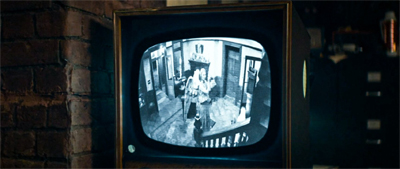
“The Loose Canon recreation is better.”
The “base-under-siege” is a classic mode of Doctor Who. Basically, the story template finds the Doctor trapped in a remote location with a supporting cast, menaced by a monster that poses a very serious risk to the group and possibly mankind as a whole. This type of story was popularised during the tenure of Patrick Troughton. They were becoming the show’s default mode during 1967: The Underwater Menace, The Moonbase, The Macra Terror, The Faceless Ones, The Abominable Snowmen. They’d continue to be popular for decades. Even in the Chibnall era, Arachnids in the U.K. and The Tsuranga Conundrum sort of count.
So there’s something faintly clever in building a loving tribute to that classic Doctor Who template set during the breakout period for that kind of story. At one point during Village of the Angels, the Doctor sets up a black-and-white feed from the hallway of the house to the television in the basement, to allow the characters to watch the infestation in real time. The Weeping Angels burst into the house, and the characters watch the black-and-white footage in horror.
The Weeping Angels move in fits and starts, transitioning from one still image to another. It’s a very clever way of acknowledging that so many of these classic Troughton era “base-under-siege” stories have been lost, and exist primarily as reconstructions from still images. There’s a real sense in Village of the Angels that the Doctor has travelled back in time to the late sixties to force Professor Jericho to watch a reconstruction of a classic serial. Moffat played with a similar concept when Bill watched the still footage of the Doctor in World Enough and Time, but it’s a good enough joke that it merits recycling.
Indeed, the premise of Village of the Angels doesn’t jsut draw from Doctor Who history. It also suggests another classic horror from the late sixties. “How can we evacuate when we’re surrounded?” Claire asks when Jericho suggests retreat. “Exactly,” the Doctor responds. “The building’s surrounded and there’s more of them than there are of us. At least inside, we have a defendable position. The basement’s securable, right, Professor?” The image of the characters hiding in the basement as the monsters bang at the outside of the house recalls the set-up of George Romero’s Night of the Living Dead.
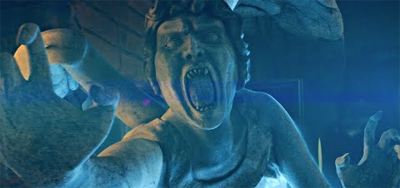
A fresh angle on the Angels of Old.
Again, this is somewhat par for the course for Alderton. It ties a classic mode of Doctor Who to a larger piece of horror history, just as The Haunting of the Villa Diodati connected the base under siege to gothic horror and the Cybermen back to Frankenstein. It’s a very clever and sophisticated way of approaching a very old-fashioned approach to writing Doctor Who. Alderton doesn’t reinvent the wheel, but she’s not trying to.
In some ways, Alderton’s approach with The Haunting of the Villa Diodati and Village of the Angels feels like an extension of Chibnall’s own approach in episodes like The Ghost Monument and The Battle of Ranskoor Av Kolos, trying to channel the work of pulp science-fiction (and Doctor Who) writers like Terry Nation for modern television. It’s worth acknowledging that modern Doctor Who has often struggled to turn the classic “base-under-siege” model into compelling television – notably with episodes like The Rebel Flesh and The Almost People – so Alderton deserves credit for cracking the template in a way that looks effortless.
After all, the traditional structure of both The Haunting of the Villa Diodati and Village of the Angels is perhaps the least interesting thing about them. Both stories are notable as efforts to reinvent old monsters, to make familiar enemies feel scary again. Village of the Angels marks the return of the Weeping Angels, perhaps the most iconic and enduring monsters of the revival. It’s notable that Village of the Angels just takes for granted that the audience remembers roughly how the Angels work, even though they last appeared in Hell Bent in December 2015 and were last featured in The Angels Take Manhattan in September 2012.
It’s perhaps revealing that Alderton doesn’t actually feel the need to reinvent the Weeping Angels. Instead, Village of the Angels feels very much like an attempt to distill the various iterations and conceptualisations of quantum-locked assassins that have appeared on screen since Blink was broadcast in June 2007. It’s notable that the episode’s biggest revelation about the Weeping Angels is just rendering explicit a bit of continuity that Russell T. Davies broached in The End of Time, Part II.
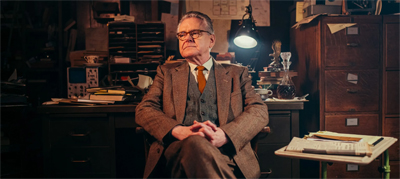
The Prof of the matter.
In Village of the Angels, the Weeping Angels play all the hits. At one point, the Doctor and Jericho try the famous “get two Weeping Angels to look at each other” resolution from Blink. At another point, the Weeping Angels taunt the characters by using familiar voices, recalling Time of the Angels and Flesh and Stone. The implication that the Weeping Angels have turned the entire village into a feeding zoo, feeding multiple times on the same victims, recalls just one of the premises at play in The Angels Take Manhattan.
Alderton leans heavily into the metafictional horror of the Weeping Angels, which was implicit in Blink and articulated in Time of the Angels and Flesh and Stone. The Weeping Angels are scary because they are conceptual in nature. They exist as ideas. The image is represents something so horrifying that it can never be fully expressed. This involves simply reiterating Time of the Angels and Flesh and Stone in a more traditional horror setting: the Weeping Angels coming through the television, the idea that an image of a Weeping Angel is a Weeping Angel, the possibility that the idea of a Weeping Angel is a Weeping Angel.
Village of the Angels doesn’t reinvent the Weeping Angels, but that’s not a problem. Dalek didn’t necessarily reinvent the Daleks; even the sequence of the Dalek climbing the stairs came from Remembrance of the Daleks. Indeed, Village of the Angels simply structures these ideas into a thrilling rollercoaster. Jamie Magnus Stone’s direction is particularly impressive, particularly in that long take during Claire’s hallucination in the bathroom, when she imagines herself turning into an Angel. It’s a genuinely haunting and unsettling sequence, a showcase for the production team.
Similarly, Alderton’s script has some fun playing with these established rules. The Weeping Angel bursting through the television is a riff on a great sequence from Time of the Angels, but the image of the spectrograph drawing a Weeping Angel is suitable novel and unsettling. Reflecting the general aesthetic of The Haunting of Village Diodati, there is some very effective occult imagery at play, particularly when the Weeping Angel attempts to manifest itself from Claire’s drawings. When the Doctor sets the drawing on fire, the Weeping Angel bursts into flames, like something from William Blake.
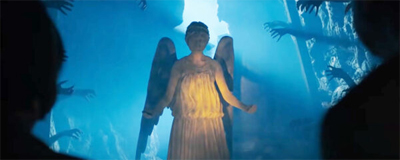
Sinister handywork.
Most of the stuff with the Weeping Angels works beautifully. There are only a few moments when Village of the Angels tips over into some of the larger issues with the Chibnall era, such as a need to over-explain everything, and to turn ambiguous continuity into clumsy exposition. Village of the Angels reveals that the Weeping Angels are working as “an extraction team” for “the Division.” More to the point, the cliffhanger seems to suggest that the Weeping Angels have the ability to convert Time Lords into other Weeping Angels. This serves to make the monsters more knowable and rational, more cleanly motivated and explained.
Much like the decision to frame Vinder’s story in Once, Upon Time through the lens of an “internal affairs” plot from a police procedural, the decision to portray the Weeping Angels as “an extraction team” feels like an effort to position most of the important elements of the Doctor Who mythos within the language of police shows. Previously, the Weeping Angels had been presented as opportunistic predators or scavengers, so this characterisation feels very much like a change.
It also feels very much like the narrative choices built around explaining the Sontarans in War of the Sontarans, attempting to offer an in-universe explanation for details like the probic vent or the fact that the non-featured aliens tended to keep their masks on. Village of the Angels seems to want to explain what the Weeping Angels are and what they want. It’s even revealed that they travel the universe in gigantic stone ships, in what feels like a shoutout to Ghost Light.
This feels like continuity-weilding, in the same way that The Timeless Children felt like an effort to explain The Brain of Morbius. The continuity developed around the Weeping Angels in Village of the Angels feels like an extrapolation from some ambiguous statements from Rassilon in The End of Time, Part II, where his opponents are made to stand as a “monument to their shame, like the Weeping Angels of old”, while posing in the background like Weeping Angels. It seems like a reather literal interpretation of that moment to suggest that disobedient Time Lords are actually turned into Weeping Angels.
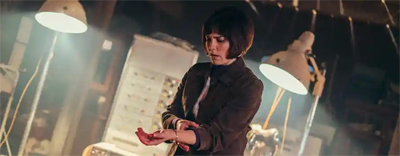
Heart of stone.
Indeed, the only really new idea in Village of the Angels is the revelation that the Weeping Angels’s feeding mechanism can be fatal – that “nobody survives it twice.” This is the only real detail in the script that feels at odds with previous characterisations of the Weeping Angels in The Angels Take Manhattan and opposed to the basic concept of the monsters. Even then, it’s an understandable fudge. As much fun as it might have been to have multiple layers within the story as the Weeping Angels cannibalise their own food supply, it’s a pragmatic choice that makes the flow of the story a bit easier to follow.
Alderton does hit upon one particularly clever idea with the Weeping Angels, honing in on a way of making the monsters’ high concept work as an effective metaphor. The original idea with the Weeping Angels is that they are a monster that forces the audience to look at them. They are a Doctor Who monster than cannot be defeated or evaded by hiding “behind the sofa.” More to the point, they are a monster that has the ability to break the fourth wall, to hunt the audience from inside the television set and to materialise simply through thought. They are a terrifying monster, particularly for younger Doctor Who fans.
However, Alderton ties the Weeping Angels to some thematic and character work, particularly with Professor Jericho. Jericho is established as a veteran of the Second World War. He mentions that he has seen terrible things, explicitly citing the liberation of the Belsen Concentration Camp. As such, it makes sense that Jericho should survive so long against the Weeping Angels. Despite their taunts to “look away”, Jericho knows what it is to look upon evil and to avoid flinching.
It’s not a particularly subtle metaphor, but it works. The Weeping Angels represent the kind of evil that cannot be defeated by looking the other way. By characterising Jericho as a veteran of the Second World War who witnessed the atrocities of the Third Reich, Alderton cleverly positions the Weeping Angels within the grand pantheon of Doctor Who villains aligned with fascism. She suggests that they are another facet of the evil embodied by the Daleks. It’s a very clever reframing of the monsters, turning them into a cautionary tale about how fascism sneaks up on those who are unwilling to meet its gaze.
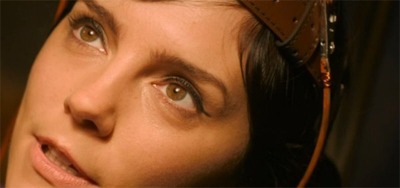
Bringing the matter to a head.
In some ways, this feels like a reworking for the Weeping Angels for the larger Chibnall era. After all, the entire moral crux of the Chibnall era hinges on the idea of observation and vigilence, even ahead of action. Stories like Rosa and Demons of the Punjab emphasise the importance of watching and learning from events. It’s notable that The Halloween Apocalypse introduced Vinder as a character tasked with watching the stars, and Once, Upon Time revealed that he had been punished for refusing to look away when the Grand Serpent instructed him to do so. The Weeping Angels are a monster only defeated by watching them.
After all, the primary character arc of Flux is built around the idea of the Doctor confronting her past. She needs to face up to what she was and what she did. It’s interesting that the usually passive Thirteenth Doctor has been so proactive in chasing down leads in The Halloween Apocalypse and wanting to remain in the time storm in Once, Upon Time. The Thirteenth Doctor wants to observe more. She wants to know more. So, in some ways, the Weeping Angels feel like a more appropriate opponent for the Thirteenth Doctor than the Daleks or the Cybermen.
As noted above, Village of the Angels takes place during the first full year of the Second Doctor’s tenure. Earlier in the year, The Moonbase had pit the Second Doctor against the Cybermen, in a story that codified a certain kind of approach to Doctor Who. Comforting his young companion Victoria, the Doctor stated that his primary role was to oppose “evil”, explaining, “There are some corners of the universe which have bred the most terrible things. Things which act against everything that we believe in. They must be fought.”
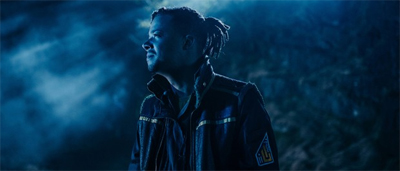
To the Vinder the spoils.
This speech is hugely important in the history of Doctor Who, because it defines what the show considers to be a “monster.” It’s the moment that reconfigures the Doctor once and for all as a completely unambiguous hero, because he fights “evil” in the personification of “the most terrible things.” Typically, evil takes the form of monsters like the Daleks or the Cybermen. After all, the Daleks were functionally the first monsters to face the Doctor, back in The Daleks. The Cybermen were the monsters present when the Second Doctor clarified his moral purpose.
So the Daleks and the Cybermen are evil that “must be fought.” In contrast, Village of the Angels positions the Weeping Angels as a slightly different sort of evil. They are the evil that must be watched. They are the creeping and encroaching evil. They are the evil that sneaks up on the victim when their back is turned or their attention is split. If the core monsters of Doctor Who are typically framed in terms of fascism, reflecting the show’s origins as a series written by those who remembered the Second World War, then the Weeping Angels are a reminder that “eternal vigilance” is the cost of the liberty that many now enjoy.
Village of the Angels repeatedly and consciously equates knowledge with power. “I observe you,” Jericho taunts the Weeping Angels. “That’s my power.” That alone is enough to hold them back, to save time. The Weeping Angel “skulking” inside Claire’s skull is being hunted for no greater reason than because it has knowledge. In some ways, Village of the Angels feels like it is as clear a distillation of the larger Chibnall era themes as Demons of the Punjab, a meditation on the importance of watching and knowing even more than acting.
The episode’s sixties setting plays into this. There are moments in Village of the Angels that evoke Hide, with the emphasis on Professor Jericho as a psychic investigator and Claire as his subject. Jenkins isn’t just interested in the paranormal, he is interested in the human brain. He’s interested in ideas that are very much wedded to the counterculture of the era, like extra-sensory perception and psychic abilities. He is chasing “a real, genuine, psychic manifestation”, the idea that a person’s thoughts can have a very real impact on the world around them.
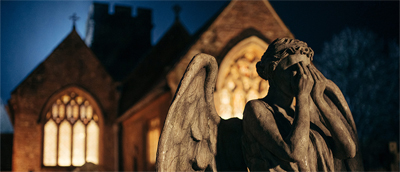
Take me to church.
This is an idea that intersects with psychedelia and the occult. After all, Jericho’s testing of Claire takes place a month-to-the-day after Allen Ginsberg’s attempts to levitate the Pentagon. What are the Weeping Angels but a literal manifestation of the fear that human ideas can warp and alter reality? It recalls River’s quotation from the book in The Time of the Angels, asking, “What if we had ideas that could think for themselves? What if one day our dreams no longer needed us?”
It should also be noted that the theme of knowledge arguably adds an explicitly religious subtext to the Weeping Angels. Despite their name, the Weeping Angels have largely been treated as a secular threat, even when they confronted the Church of the Papal Mainframe in Time of the Angels and Flesh and Stone. However, Village of the Angels leans into the religious iconography. The Weeping Angels stalk a church graveyard. They torment a man named Professor Jericho. They stand in judgment of humanity as a result of forbidden knowledge making its way to Earth. The invocation of Blake doesn’t feel like an accident.
There are other smaller interesting ideas at play in Village of the Angels. The episode does a much smoother job of separating the TARDIS crew than either War of the Sontarans or Once, Upon Time. More than that, for the first time in Flux, it feels like all three of the credited leads are all in the same episode. The decision to keep Yaz and Dan together while separating the Doctor is a very canny piece of writing, because it plays well to the different levels of experience within the TARDIS team.
Notably, it allows Yaz to assert her position as the more senior companion, and to demonstrate that she sees herself as equivalent to the Doctor. She borrows the Doctor’s line about the “very flat team structure” from Fugitive of the Judoon and The Haunting of the Villa Diodati. She even mirrors the Doctor’s frustration with her impatient companion when Dan presses her for answers. “You have questions, Dan,” she sighs at one point. “I get it!” It’s not quite at the level of “does everything have to be a debate?”, but it’s almost.
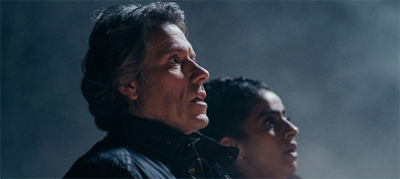
“Yaz, sir.”
That said, it is mildly frustrating that – like so much of the Chibnall era around it – this leadership position is equated with law enforcement. When Yaz and Dan assist with the search for Peggy, Yaz immediately starts running it like a police officer, inquiring about Peggy’s favourite areas and asking, “Are you prioritising those?” It’s a sequence that makes sense in the context of the larger era around it, but it comes unsettlingly close to asserting the that ideal successor to the Doctor is a police officer.
There’s also something clever in the way that the presence of the Weeping Angels seems to distort the structure and rhythms of Doctor Who, as if inviting younger viewers to wonder whether the Weeping Angels in the television have some ability to control the program around themselves. Village of the Angels is notable for featuring a warped and distorted version of the closing theme, and for interrupting the credits to continue the narrative. There have been stingers and teasers before, but this feels different.
At the risk of being cynical, it’s possible to position the mid-credits sequence as another example of Chibnall seeming to chase the populist blockbuster aesthetic of the Marvel Cinematic Universe. In The Halloween Apocalypse, the presentation of the Flux recalled Guardians of the Galaxy, Vol. 2 and the shrinking of Dan’s house evoked Ant Man and the Wasp. In War of the Sontarans, Swarm’s threatened finger snap seemed to riff on an iconic beat from Avengers: Infinity War. It’s possible to see the mid-credits sequence focusing on Bel and Vinder in that light.
It’s great to see Bel return after Once, Upon Time. As in that episode, Bel serves largely to establish the stakes of the show, to demonstrate the consequences of the Flux. While Once, Upon Time leaned rather heavily on recurring monsters like Daleks and Cybermen, Village of the Angels is more particular. “Space is empty now,” Bel reports. It’s an observation that seems to hark back to Swarm’s arguments about a war between space and time in the previous episode. It seems like space is winning. “Since the Flux there’s so much more… space… and so much less… everything else.”
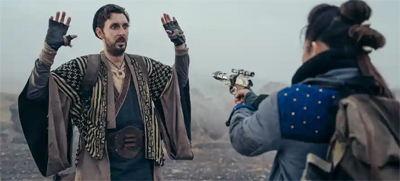
Rings a Bel.
In some ways, Bel’s small subplot with Namaca reinforces the themes suggested in Once, Upon Time. The argument seems to be that chaos drives people into the arms of monsters. It isn’t just the Daleks, the Sontarans and the Cybermen carving up what remains of the universe. People are fighting for the opportunity to be transported inside “the Passenger”, to surrender their freedom to Azure for the remote possibility of relief and escape from the horror in which they find themselves. Again, as with the portrayal of the apocalypse in Once, Upon Time, this suggests the moral underpinning of the Chibnall era’s conservatism.
Village of the Angels is a clever and well-produced episode, one that stands as a highlight of Flux to this point.
Filed under: Television | Tagged: Chris Chibnall, doctor who, maxine alderton, village of the angels, Weeping Angels |




















“It’s notable that Village of the Angels just takes for granted that the audience remembers roughly how the Angels work, even though they last appeared in Hell Bent in December 2015 and were last featured in The Angels Take Manhattan in September 2012.”
I feel like The Halloween Apocalypse explained this pretty thoroughly, though I guess you might still get the odd viewer jumping in mid-season.
I didn’t end up watching last week’s episode, but I might check this one out since Diodati was one of the better episodes last season and the Weeping Angels are pretty neat. Will I be able to follow it without Once, Upon Time?
Watched it. I honestly feel, as with War of the Sontarans, that it would work far better as a standalone without the Flux stuff constantly cutting in. Probably the weakest angel ep imo. I do hope Alderton gets a chance to do a proper standalone at some point though.
I’d agree with that assessment.
You’ll probably be able to follow it, but you may get frustrated by the episode’s lack of an ending.
Well, after all, Yaz IS a police officer! It made sense to me that she would talk like one. 😉 I smiled in that scene…
Yeah. I can’t complain since one of my issues with the last two seasons was how often the show seemed to forget that Yaz was a police officer and would have skills related to that job.
That’s fair. But I’d still feel better if she was actually learning things from her experiences with the Doctor that applied to her time as a police officer, rather than discovering that being a police officer is a set of transferrable skills that are perfectly suited to being a Doctor Who companion.
To be fair, it’s just something that sits within the larger themes of the era around it in ways that I found very revealing.